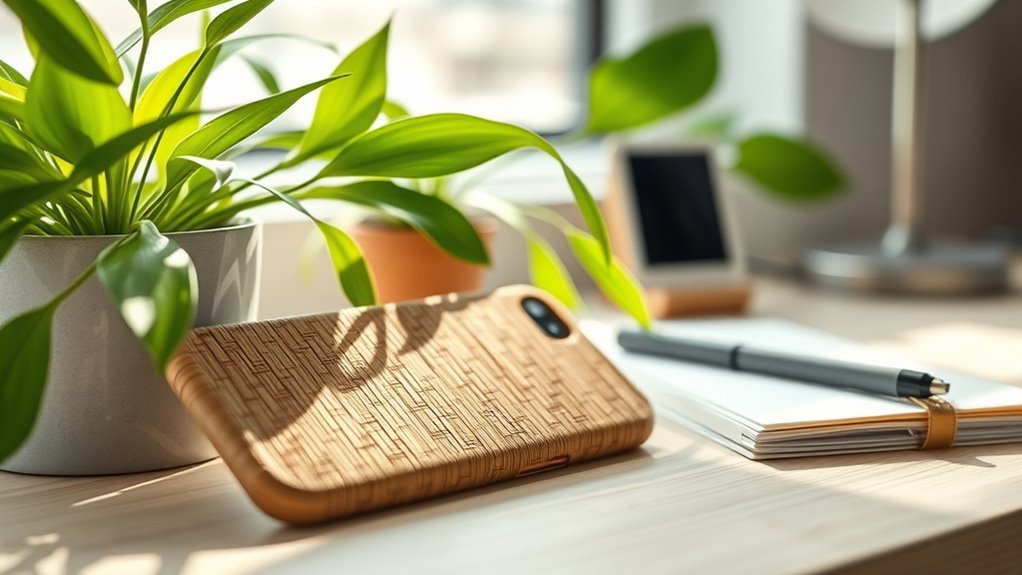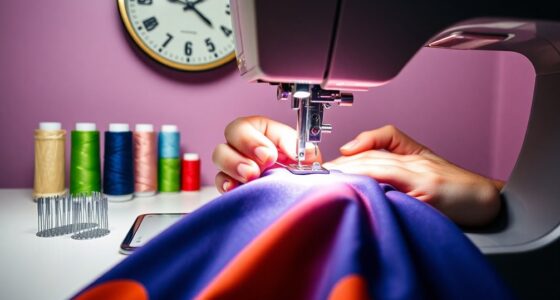Did you know there are eco-friendly interfacing options beyond traditional synthetics? Organic fibers like hemp, linen, bamboo, and organic cotton provide biodegradable, sustainable choices that offer the same stability for your projects. You can also explore plant-based materials like cornstarch or cellulose that break down naturally over time. These alternatives support eco-conscious sewing without sacrificing quality. Keep exploring to discover more environmentally friendly options that can transform your craft and reduce waste.
Key Takeaways
- Natural fiber interfacings made from organic cotton, hemp, or bamboo offer biodegradable and sustainable alternatives to synthetic options.
- Plant-based, compostable interfacings crafted from cornstarch or cellulose decompose faster and reduce landfill waste.
- Some eco-friendly interfacing options provide comparable stiffness and durability for structured sewing projects without harmful chemicals.
- Many brands now offer environmentally conscious interfacing, making sustainable choices more accessible for eco-friendly crafting.
- Using biodegradable interfacings supports circular economy practices by allowing materials to naturally decompose after disposal.

Choosing eco-friendly interfacing alternatives can substantially reduce the environmental impact of your sewing projects. Traditional interfacing often contains synthetic fibers and chemicals that are not biodegradable, contributing to long-term waste in landfills. By exploring sustainable materials and biodegradable options, you can make more conscious choices that benefit the planet. These alternatives are designed to serve the same purpose—adding structure and stability—without sacrificing your commitment to eco-friendliness.
Opt for eco-friendly interfacing to cut waste and support sustainable sewing practices.
Sustainable materials for interfacing include options made from natural fibers like organic cotton, hemp, linen, and bamboo. These fibers are renewable, require fewer chemicals during cultivation, and often have a lower environmental footprint than synthetic counterparts. For instance, organic cotton interfacing provides the sturdiness needed for garments and accessories while being biodegradable and free from harmful dyes or chemicals. Hemp and linen are incredibly durable, and their biodegradability means they’ll decompose naturally once discarded, reducing landfill waste. Using these natural fiber options not only supports sustainable farming practices but also aligns with your goal of reducing your carbon footprint.
Biodegradable options further enhance your eco-friendly sewing practices. These interfacing materials are designed to break down naturally over time, leaving no harmful residues behind. Many biodegradable interfacing products are made from plant-based materials like cornstarch, cellulose, or other biodegradable polymers. They perform similarly to conventional interfacing but decompose much faster once disposed of, minimizing environmental harm. When choosing biodegradable options, look for products that are certified compostable or labeled as biodegradable, ensuring they meet environmental standards. This way, you’re actively reducing waste and supporting a circular economy where materials return to the earth without polluting.
Incorporating these eco-friendly alternatives into your sewing projects doesn’t require sacrificing quality or functionality. Many sustainable and biodegradable interfacing options are engineered to provide the necessary stiffness and durability for various projects, whether it’s a structured bag, a tailored jacket, or decorative accents. Sometimes, you might need to experiment with different materials to find the best fit for your specific needs. Additionally, selecting biodegradable materials that are also free from synthetic chemicals can further enhance the sustainability of your sewing projects. Fortunately, more brands are now offering environmentally conscious interfacing options, making it easier than ever to craft with sustainability in mind.
Frequently Asked Questions
Are Eco-Friendly Interface Options Compatible With All Devices?
You wonder if eco-friendly interface options work with all devices. While many eco-friendly interfaces use wireless connectivity, compatibility varies depending on your device’s user compatibility and technology. Some eco-friendly options are designed to be universal, but others may require specific features or adapters. It’s best to check each product’s specifications to guarantee seamless integration with your devices, ensuring smooth performance without compromising sustainability.
How Do Eco-Friendly Interfaces Compare in Durability?
Eco-friendly interfaces often have comparable durability to traditional options, especially when made from high-quality biodegradable materials. These materials are designed to withstand daily wear and tear, ensuring longevity. Plus, their production relies on renewable energy, reducing environmental impact without sacrificing strength. You can confidently choose eco-friendly interfaces, knowing they’re durable and sustainable, supporting both your needs and the planet’s health.
What Is the Cost Difference Between Traditional and Eco-Friendly Interfaces?
You’ll find that the cost comparison between traditional and eco-friendly interfaces varies. Eco-friendly options often have a higher initial price due to sustainable materials and manufacturing processes. However, a thorough price analysis shows they can save you money over time through lower maintenance and energy costs. Though the upfront investment might be higher, many eco-friendly interfaces provide long-term financial benefits, making them a smart choice for environmentally conscious consumers.
Can Eco-Friendly Interfaces Support High Data Transfer Rates?
Did you know that eco-friendly interfaces can support high data transfer rates? You might think sustainability limits performance, but many eco-friendly options now meet the latest wireless standards, ensuring fast speeds. They also maintain signal stability, essential for reliable data transfer. So, yes, eco-friendly interfaces can handle high data demands, offering both performance and environmental benefits. You don’t have to compromise quality to go green.
Are There Any Certifications for Eco-Friendly Interfacing Products?
You might wonder if eco-friendly interfacing products have certifications. Yes, many do. Look for sustainable labeling and eco certification standards like FSC, EPEAT, or ENERGY STAR, which verify their environmental claims. These certifications guarantee the products meet strict sustainability criteria, giving you confidence in choosing eco-conscious options. Always check for reputable labels to confirm the product’s eco-friendly status and support sustainable practices.
Conclusion
Imagine sewing a quilt with scraps of old shirts instead of new fabric—sustainable, creative, and kinder to the planet. Just like that, choosing eco-friendly interfacing options reduces waste and lowers your environmental footprint. Every small switch, like using organic or biodegradable interfacing, adds up—kind of like planting a seed that grows into a lush garden. So, next time you sew, remember: your choices can craft a better world, one stitch at a time.









